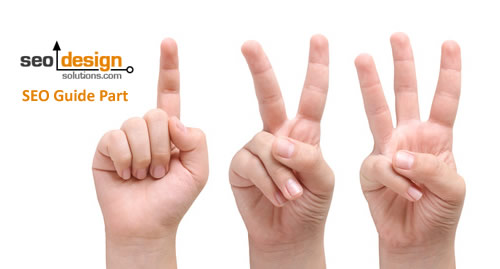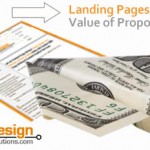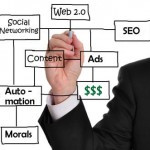It’s easy to point fingers when the phone is not ringing and the leads have trickled to a halt. But is that really the best way to optimize your business?

Is SEO or Conversion to Blame?
Instead of blaming the SEO guy or team when things don’t work out, oftentimes it’s a matter of conversions and conversion optimization, meaning – redesigning the website or creating specific landing pages that appeal to the consumers that frequent them. If your online business relies on conversions occurring on your pages, then you need to pay attention to what matters most – pleasing the visitor AFTER they arrive instead of just focusing on (a) what happens before they get there or (b) blindly getting more traffic to slip through the those pages.
How many times have you clicked through to a top ranking result, only to find a dated website or tacky landing page with no defined purpose in sight, a flimsy value proposition (if it even exists) or a weak call to action?
Despite their best intentions, this is clearly an example of someone being too close to a website who cannot determine if their website lacks performance, if it is possible of being improved (from trying something else) or if that site is merely on life-support.
Conversion Paths or Pages?
Does your product or service warrant a conversion path or a landing page? Depending on the climate of the consumer, the price point, how valuable the product or service is for their businesses survival of if it is an ancillary accessory.
Sure, people may spend $19.95 on an e-book, but that is not the same consumer who will spend $2000 on a bona fide solution. Similarly, you need to qualify the needs of your audience and provide them with enough information to persuade them to make an intelligent/left brained logical (central route processing) purchase (like a house, car, expensive piece of equipment or service) or an emotional/impulse (periphery route processing) decision.
The elaboration likelihood model (ELM) is based on this premise that people will spend more time on purchases that cost more than impulsive lower price point or value thresholds. For more on this and 100 other tactics used from ad agencies to sell anything to anyone, a link is provided to Drew Eric Whitman’s masterpiece “Ca$hvertising” at the end of this post.
If you come prepared when selling items with a higher price point and offer statistics, emotional triggers or methods to validate “social proof” that your product or service significantly satisfies their aliment, you can replace ignorance and scratching your head trying to figure out what’s wrong with your site with actionable intelligence you can couple with highly converting landing pages or conversion paths.
Setting the Stage for Conversion
Landing pages are ideal as pre-sell pages that provide an immediate benefit:
- Outline the problem with context
- Provide an angle, solution or free download of some sort in exchange for a name and email
- Offer the download as instant gratification as a result of the action/reward modality.
On the contrary, to get a conversion for a sale on a high-ticket item you may need to:
- Segment the traffic type and lead them through a 3-4 page conversion path
- Determine cues along the way (through yes / no or drop down menus) to eliminate diffusion
- Provide alternative solutions (calculated on their previous input) to provide the most relevant offer
As a result, even though you spent more time to get to the meat of what it is THEY need and NOT what you THINK THEY NEED, this can often produce significant increases in conversion as a result of asking and not assuming – which leads to the next point.
Realizing Your Website is Flawed
The truth hurts, but when it comes down to the two facets of (1) what is good for the webmaster/business owner and (2) what is good for the user, the visitors preference should define the monetary precedence. Failed Conversions can be derived from (1) lack of clarity on your page (2) too many options or (3) overwhelming graphical or textual elements which overpower the feel and function of a page.
The First Step in Recovery from Bad Landing Pages
Leading people though a series of mini-conversions “is the idea”; this is the precursor to visitor segmentation and conversion paths. Each click provides the visitor with an even more tailored and suitable circumstance by design.
Take a travel site for instance, if you have an excessive amount of heavy navigation, useless filters, muted colors or a narrow color palate and you are trying to whisk people away before they have even told you where they’re going – then you need to stop putting the cart before the horse.
If you on the contrary (a) asked them what the destination is in the first conversion objective (b) refined or eliminated other choices by suggesting a selection (villa, apartment, cottage, etc.) and then (c) used a minimalist design and tactful use of color to distinguish important elements you could eliminate conversion confusion.
Creating a simple, clear conversion path is the best way to ensure that the right visitors get to the right page (to make a decision, take action or peruse your offer). For more on this tactic and many others, I suggest you read the book provided by Ion Interactive called “Honest Seduction” you will not be disappointed (you can order the book from Amazon if you wish using the link provided at the end of this post).
There is a chronological process that typically unfolds over the course of a series of clicks. Of the three classifications of search behavior (informational, navigational and transactional) tuning the attention from a nebulous flashlight to a laser-like focus provides fewer options to distract the objective.
By simplifying the mental / visual tug-of-war one potentially encounters when skimming pages, the conversion objective that works wonders every time is (the big shiny unobstructed button) which is an attribute of Fitt’s law or an elements of button balance (to prioritize a preference and entice a visitor to take action).
Rather than break out the pros vs. cons of conversion, taking an aerial approach to the conundrum to find alternative ways to view the circumstance is what is suggested by this post. The takeaway here is “sales are the bottom line”, don’t blame the messenger for the message and don’t expect SEO to increase the bottom line “if you haven’t thought of what happens when the visitor arrives”.
Both must work in tandem to produce the proverbial one-two punch that means that despite the traffic source or keyword used to deliver a potential prospect to your page, that the design congruence, persuasiveness of the content and the imagery used all reinforce one synergistic action, and that action has been qualified, is frictionless to their objectives and produces short-term (immediate) and long-term (benefit) for their dilemma or circumstance.
What happens next it elementary, they proceed and purchase, download, subscribe or checkout on your website (or they find a competitor) who has provided more attention to detail for those critical conversion cues is up to you and how well you craft your landing pages and copy. As promised here are the two resources I referenced in the post.
and
You can purchase either book on Amazon or use our affiliate links above to purchase. I have read both books and they are a welcomed addition to any internet marketer’s arsenal for coupling landing pages and purpose to increase leads, sales and conversions.











Yes I agree to that factors that you have to check before pinpointing. You should check out what’s wrong within the site before complaining in the first place.
Conversion benchmarks should always be assessed prior to an SEO campaign. If you can’t measure it, you can’t improve it.
Relevance and conversion are a moving target, you have to nimble and pliable to let go of what is not working and test, test and test new variables.
Great post on the importance of conversion optimization, and thanks for the shout out to Honest Seduction! SEO and CRO (Conversion Rate Optimization) are the perfect couple for leading online marketing strategy – so great to see an SEO advocate for CRO!
@Kristina:
It is the one two punch for online marketing after all. (1) drive traffic (regardless of paid of organic) and (2) convert it, had to pass the hat tip, because it is a great book.
Take care and thanks for visiting.
Yes it’s very easy for the client to look for someone to blame when their rankings change. I think some of the them think we are in collaboration with Google themselves, when really this is a probably a simple algorithm change or quite simply serps flux.
Good post, very informative.
A good SEO will look at the usability and conversion factors of the site beforehand. I wouldn’t implement a campaign for a website I didn’t think would convert, you’re just asking to be blamed.
@Wayne:
Thanks Wayne, just reflecting on that comment makes things like the Florida update, Big Daddy and Mayday come to mind.
Quality and relevance are timeless, so, better to stick with those metrics when building a long-term SEO strategy that is resilient enough to bounce back after algorithmic variations.
@Jamie:
That’s why we implement landing page optimization and creation as well as SEO, but yes, better to know what your starting point is to find the websites flaws and recalibrate the nodes of conversion needed to take it from lackluster to blockbuster.
Thanks for commenting.
Kristina is right, SEO and CRO just go together. Thanks for the article. I tweeted it.
SEO is one aspects of creating online presence which helps you get targeted traffic but as in all marketing campaigns just getting the leads is not enough it is the conversion of these leads to sales which is the be all and end all of the campaigns for which the team effort of the marketing team and the sales team is needed.
SEO is a part of marketing but the aspects of a good landing page act like your sales team navigating the potential customer in the right direction and helping him in taking the decision by offering a simple friendly design and structure to buy and pay online with confidence and trust.
Genuine SEO takes a lot of effort and time to make the website rank on page 1 of the search engines. It is like displaying your product in one of the best showrooms available online but before doing that the website owner and the developer should make sure whether their product is worth being displayed on such a platform if they want conversions else it is a sure waste of time effort and money.
No one has to be blamed but such a situation surely requires an open approach from the developer, the SEO and the website owner to come to a constructive conclusion to boost conversions.
I know this is easier said than done but that is the truth.
Related posts on my blog:
http://blog.webpro.in/2010/08/conversion-ratio-analysis-and-approach.html
Its interesting to see that SEO companies are all entering the next stage… client that want conversions and not visitors and pageviews. Filling the funnel is SEO but then optimizing the funnel to get conversion CRO is something SEO people can grow into as well.
Its different field, with its own best practices and landing-pages etc. But not undoable to learn.
I suggest SEO’s go for it extend the business to CRO and keep the client happy.
You can use http://www.reedge.com to create funnels, conversion rate testing (multivariate/ab) and much more. Its free.
Dennis
Thanks Dennis:
Nice product and white paper by the way, we definitely will be using your platform for CRO testing…
Thanx Jeffrey, next month I’ll publish the content of the whitepaper in an article for all to read (without leaving details).
Hope you like the product, if you need help use dennis (at#@#) reedge dot com
Regards,
Dennis